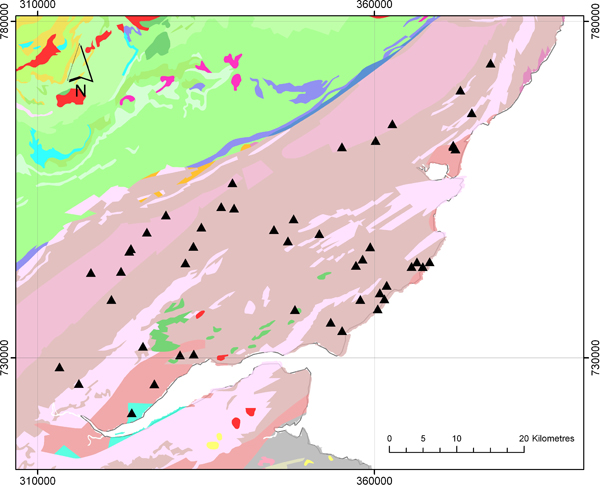Home
»
Our research
»
Groundwater science
»
Research areas
»
Groundwater quality and protection
»
Baseline chemistry of groundwater in UK aquifers
»
Baseline Scotland
» Strathmore
Strathmore
A total of 48 groundwater samples, collected from boreholes, springs and shallow wells, were used to interpret the chemistry of groundwater in the high productivity Devonian sedimentary aquifer.
Download the Baseline Scotland: the Lower Devonian aquifer of Strathmore report.
Baseline data
Main findings
The collection and interpretation of new groundwater chemistry data for the Strathmore area has led to the following conclusions:
- The groundwaters of the Devonian aquifer in Strathmore are mainly weakly mineralised, with TDS concentrations mostly less than 400 mg/l. Groundwaters have near-neutral to slightly alkaline pH values and are for the most part oxygenated, with detectable dissolved oxygen and high redox potentials. As a result, dissolved iron, manganese and ammonium (NH4-N) concentrations are usually low. Water from shallow boreholes and springs is often undersaturated with calcite, but in deeper boreholes, reaction with carbonate minerals in the aquifer is more usual and most of these are saturated with respect to calcite.
- Nitrate concentrations are often high and nearly one third of the samples exceeded the EC drinking water limit for nitrate of 11.4 mg/l.1 as NO3-N. Under the oxidising conditions, nitrate is a stable solute species across the aquifer and is found at depths in excess of 100 m.
- Concentrations of phosphorous in groundwater across the aquifer are typically less than 0.1 mg/l.. Given the importance of P in controlling eutrophication in surface water, these concentrations in groundwater may be significant.
- Increased salinity occurs in groundwater in some near-coastal boreholes, most likely as a result of mixing with seawater.
- Most trace elements have low concentrations, in accordance with the neutral pH groundwater conditions. Concentrations of arsenic are relatively high in some groundwaters (up to 8.8 μg/l), though none exceeds the EC maximum permissible value for drinking water of 10 μg/l. Concentrations of uranium reach up to 15.4 μg/l, with the highest concentration just exceeding the WHO provisional guideline value for drinking water of 15 μg/l. Two other exceedances above maximum permissible values for drinking were observed, for nitrite (highest concentration 0.194 mg/l.) and fluoride (highest concentration 3.7 mg/l.).
- The chemistry and residence time indicators (CFC and stable isotopes) indicate that the groundwaters are largely of young age, being mostly recharged within the last 40 years, with mixing throughout the top 100 m of the aqufier. The young age of the groundwaters means they are vulnerable to contamination.
- The most significant groundwater-quality problems identified by this survey are:
- The widespread presence of elevated nitrate concentrations in groundwater, which is strongly linked to agricultural activity;
- Elevated phosphate concentrations, which may affect the quality of surface water when discharged to rivers as baseflow.
- The presence of saline water in some near-coastal boreholes, indicating localised saline intrusion. It is not clear to what degree the saline intrusion is natural and to what degree it has been enhanced by over-pumping.
Data
- Devonian Strathmore aquifer — Summary statistics of groundwater chemistry (1 of 2)
- Devonian Strathmore aquifer — Summary statistics of groundwater chemistry (2 of 2)
- Strathmore groundwater — Piper diagram of the major ion chemistry
- Ca, Mg and HCO3 and Cl, SO4, NO3-N — Maps illustrating spatial variation in the concentration
- Na, K and P and F, Fe and Mn — Maps illustrating spatial variation in the concentration
Baseline report
Ó Dochartaigh, B. É., Smedley, P., MacDonald, A. M. and Darling, W. G. (2004) Baseline Scotland: the Lower Devonian aquifer of Strathmore. Commissioned Report, CR/06/250N. British Geological Survey.
Research areas
Data, information and services
Research resources
People and collaborations
UK Baseline
Scottish Pre-Baseline Data
Baseline Scotland Data
Related content







